

 The first thing we just have to tell you is that our new book won the prize as Best Wine Book for Professionals in Sweden by the Gourmand World Cookbook Awards! We just received the information a few days ago. We are so happy!
The first thing we just have to tell you is that our new book won the prize as Best Wine Book for Professionals in Sweden by the Gourmand World Cookbook Awards! We just received the information a few days ago. We are so happy!
In addition the book has also been nominated for to the same category for the international award! Who will win the prize and become the world’s best wine book for professionals will be revealed in Paris on February 23!
We are excited.
And then: If you have not yet “liked” us on Facebook, please do so now. Here’s where you find BKWine Magazine on Facebook. Tell your friends to like the page too! It is the best Christmas present we can hope for. (And it is very affordable.) And while you are at it, why not like our wine travel page too?
Now to even more vinous matters.
It is not easy for lesser-known wine regions to make their voice heard above the choir of the big and famous districts. We were reminded of that recently in Turkey where we were on what is now called the Digital Wine Communications Conference. We had the opportunity to taste a large number of Turkish wines. Some were very good, some were more “interesting”. But all of it was quite far away from one of the few Turkish wines that I had heard of before I went there: Beyaz. I don’t think it exists any longer.
It was quite popular when I started drinking and tasting wines, quite a few years ago, in Sweden. It was a semi-sweet or semi-dry (memory fails.Did it matter?) white wine. Popular perhaps not primarily for its taste and character. I wondered if I would run into it again, when in Turkey.
And yes, suddenly I saw a wine that said “beyaz” on the label. So I asked the producer, ”is this really ’beyaz’?” He looked back puzzled and said, “yes, can’t you tell?” It turns out that beyaz is simply Turkish for white… (For some obscure reason there is actually also a birth control pill called beyaz!)
There were two main groupings of Turkish wines: those made from “international” grape varieties (cabernet, chardonnay, sauvignon etc), and those made from Turkish indigenous grapes (brace yourself: öküzgözü, boğazkere, kalecik karası etc). What is the best strategy for a country that is quite unknown as a wine producer? Go for wines that are easily recognised on the international market, but that are made, similarly, in many other places around the world? Or go for the stranger product with names that no-one has heard of and can hardly pronounce?
Not an easy choice. But a choice that is very similar to what many other wine regions are facing. Personally I would rather buy a Turkish boğazkere (pronounced ‘boaskere’, not that hard finally) rather than a Turkish cabernet sauvignon. And you? A question that we will come back to in a future article. Do send us an email if you have any opinions or comments.
What about some Christmas gift tips?
– The obvious one: a gift voucher for a wine tour
– A bottle of wine from an unusual grape variety or from an obscure wine district
– A wine magazine subscription. We recommend Decanter, or Revue des Vins de France
– An outstanding wine glass
– A curious wine decanter
Britt & Per
PS: Recommend to your friends to read the Brief!
– – – – –
What’s on at BKWine Tours
- Chile & Argentina, 4-19 February
- South Africa, 1-11 March
- Bordeaux, 22-26 May
- Bordeaux, 18-22 September
- Douro Valley, Portugal, 23-27 October
For more information please contact us on email or on phone (we’re on French time), or go to our wine travel site on www.bkwinetours.com!
We also make custom designed wine tours – on-demand tours for you and a group of friends, for your company (maybe to scout new winegrowers?), for a special event… We can combine winery visits and wine touring with other activities: gastronomic workshops, visit to an oyster farm, truffles hunting, cheese making, and more. More info on the custom designed and bespoke BKWine wine tours and travel here!
Wine tours in Finnish: We also do wine tours in Finnish. And in German, Norwegian, Spanish…
Do you want the latest news and updates on our wine travel activity? Subscribe here! (Second alternative BKWineTours.com)
From the World of Wine
Best wine book in Sweden and nominated to World’s Best!
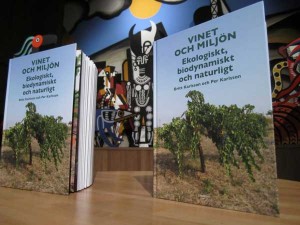 Good news! We have just learned, hot off the presses, that our new book has won the award “Best wine book in Sweden for professionals” in the Gourmand World Cookbook Awards! The book is called Wine and the Environment, Organic, Biodynamic, and Natural (published in Swedish).
Good news! We have just learned, hot off the presses, that our new book has won the award “Best wine book in Sweden for professionals” in the Gourmand World Cookbook Awards! The book is called Wine and the Environment, Organic, Biodynamic, and Natural (published in Swedish).
We are very happy and proud!
The book is also nominated to the category “World’s Best Wine Book for Professionals” on the next level of the competition and has the chance to be selected as the world’s best wine book!
Read more about the book award and the Gourmand competition on BKWine Magazine!
(Our previous book, The Creation of a Wine, was the international award winner in the same category in 2010/2011 and thus became the world’s best wine book for professionals then.)
One of our favourite restaurants in Florence
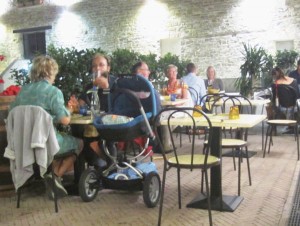 There are almost innumerable restaurants in Florence, anything you may want from luxury and abundance to a quick pizza to go. One that is in the category friendly neighbourhood restaurants is Le Carceri (i.e. The Prison). We have previously written about it in a restaurant review and now we have added a few videos and pictures from Le Carceri that we have published in our travel blog on the wine travel site.[divider_flat]
There are almost innumerable restaurants in Florence, anything you may want from luxury and abundance to a quick pizza to go. One that is in the category friendly neighbourhood restaurants is Le Carceri (i.e. The Prison). We have previously written about it in a restaurant review and now we have added a few videos and pictures from Le Carceri that we have published in our travel blog on the wine travel site.[divider_flat]
Wine in bulk, a growing market, Spain is top producer
 Larger and larger quantities of wine in the world are sold in bulk. The volume has doubled over the past 10 years. Spain is the leading country when it comes to selling bulk wine (35% of the total bulk volume in the world). Italy comes second (23%) and Australia is the third largest in terms of volume. In terms of value, however, France beats Australia och ends up third. The French get paid an average of one euro per liter bulk wine compared with the global average price of 63 cents. Read more at vitisphere.com
Larger and larger quantities of wine in the world are sold in bulk. The volume has doubled over the past 10 years. Spain is the leading country when it comes to selling bulk wine (35% of the total bulk volume in the world). Italy comes second (23%) and Australia is the third largest in terms of volume. In terms of value, however, France beats Australia och ends up third. The French get paid an average of one euro per liter bulk wine compared with the global average price of 63 cents. Read more at vitisphere.com
All wine shipments in containers larger than two litres are for the moment considered as bulk wine in the statistics. This means that also Bag in Box of more than 2 litres is statistically counted as bulk wine. This is perhaps one explanation to why this category is increasing. Many think, we included, that the definition of bulk wine should be changed and it probably will. Bag in Box is usually sold as such to the end consumer and is therefore a totally different category than bulk wine destined to be blended and/or bottled by a wholesaler.
Bordeaux wines from the 2000 vintage. Are they still good?
 Roberson Wine recently launched an internet based wine shop targeting the Swedish consumer market, as well as one in the UK. The Roberson selection is focused on top-level and exclusive wine. They introduced their activity to Swedish wine lovers by organising a tasting of rare Bordeaux wines from the 2000 vintage. BKWine’s reporter Wilhelm Arnör was there. Read the full report here: “Luxury: nine top-class Bordeaux clarets from the legendary 2000 vintage” on BKWine Magazine. On the vintage: “the catastrophe that never happened”. Wilhelm picks one of the nine wines as his overall favourite. Guess which! Can not have been easy in that heat.
Roberson Wine recently launched an internet based wine shop targeting the Swedish consumer market, as well as one in the UK. The Roberson selection is focused on top-level and exclusive wine. They introduced their activity to Swedish wine lovers by organising a tasting of rare Bordeaux wines from the 2000 vintage. BKWine’s reporter Wilhelm Arnör was there. Read the full report here: “Luxury: nine top-class Bordeaux clarets from the legendary 2000 vintage” on BKWine Magazine. On the vintage: “the catastrophe that never happened”. Wilhelm picks one of the nine wines as his overall favourite. Guess which! Can not have been easy in that heat.
The big Rhone wine jamboree: 11-14 March 2013
 Les Découvertes en Vallée du Rhône is a travelling wine show that takes place every second year in the Rhone Valley. Every appellation organises a gargantuan tasting with all the producers (well, almost). The wine trade and wine journalists go from village to village to taste. Worth a visit! Read more about this big movable Rhône feast on BKWine Magazine.[divider_flat]
Les Découvertes en Vallée du Rhône is a travelling wine show that takes place every second year in the Rhone Valley. Every appellation organises a gargantuan tasting with all the producers (well, almost). The wine trade and wine journalists go from village to village to taste. Worth a visit! Read more about this big movable Rhône feast on BKWine Magazine.[divider_flat]
One more classified biodynamic chateau in Médoc: Château Durfort-Vivens
 Château Pontet-Canet in Pauillac was the first and Château Durfort-Vivens in Margaux will probably be the second Grand Cru Classé in Médoc to become biodynamically certified. Durfort-Vivens was made as second growth (deuxième grand cru classé) in the Bordeaux classification of 1855.
Château Pontet-Canet in Pauillac was the first and Château Durfort-Vivens in Margaux will probably be the second Grand Cru Classé in Médoc to become biodynamically certified. Durfort-Vivens was made as second growth (deuxième grand cru classé) in the Bordeaux classification of 1855.
Owner Gonzague Lurton has worked biodynamically on part of the vineyard since 2009. He was inspired by Pontet-Canet but also from tasting wines from other producers belonging to the French biodynamic association Biodyvin. Alain Moueix at Château Fonroque in Saint Emilion, one of the first biodynamic chateaux in Bordeaux, has also helped him. The plans are that Durfort-Vivens will be run 100 % biodynamically next year and Gonzague Lurton will then also apply for certification. Read more in Drinks Business.
More and more chateaux are proving that Bordeaux vineyards, despite the humid oceanic climate, can be managed organically.
A super-Tuscan with Bordeaux links
 Eric Albada Jelgersma owns Chateau Giscours and Château du Tertre in Margaux in Bordeaux. But he had, apparently, money left to spend so some years back this rich Dutchman started a winery in Tuscany, on the coast, not far from where many of the “super-tuscan” wines are made. This past autumn we found our way to his remote winery on one of our wine tours with a small group of wine lovers.
Eric Albada Jelgersma owns Chateau Giscours and Château du Tertre in Margaux in Bordeaux. But he had, apparently, money left to spend so some years back this rich Dutchman started a winery in Tuscany, on the coast, not far from where many of the “super-tuscan” wines are made. This past autumn we found our way to his remote winery on one of our wine tours with a small group of wine lovers.
Here, on our travel blog, you can read some more about it and see both photos and videos from this impressive winery called Caiarossa in the Val de Cecina in Tuscany, including the Fengh Shui-inspired wine cellar.
Geographical indications for AOC Alsace
 INAO (Institut National de l’Origine et de la Qualité), the authority that controls all the French appellations, has recently approved two additional geographical add-ons for AOC Alsace. The two lucky ones are AOC Alsace Bergheim and AOC Alsace Coteaux du Haut Koenigsbourg.
INAO (Institut National de l’Origine et de la Qualité), the authority that controls all the French appellations, has recently approved two additional geographical add-ons for AOC Alsace. The two lucky ones are AOC Alsace Bergheim and AOC Alsace Coteaux du Haut Koenigsbourg.
Previously 11 geographical areas have been given this higher status: Blienschwiller, Côtes de Barr, Cote de Mulhouse, Klevener the Heiligenstein (for the grape klevener), Strasbourg, Rodern, Saint-Hippolyte, Scherwiller, Vallée Noble, Val Saint Grégoire and Wolxheim. The total number is thus now 13 and no more areas are in the pipeline. Read more at lavigne-mag.fr.
These wines with a geographical indication are supposed to be a category sort of half way between a normal AOC Alsace and an Alsace Grand Cru.
Good news for organic growers: new organic product to fight diseases
 Swiss researchers have discovered fungal molecules in lignified vine branches that can slow the progression of mildiou, oidium and gray rot, all three dreaded fungal diseases in the vineyard. The Research Station Agroscope Changins-Wädenswil in Switzerland will now try to develop a new pesticide based on these molecules.
Swiss researchers have discovered fungal molecules in lignified vine branches that can slow the progression of mildiou, oidium and gray rot, all three dreaded fungal diseases in the vineyard. The Research Station Agroscope Changins-Wädenswil in Switzerland will now try to develop a new pesticide based on these molecules.
The project is financed by a very prestigious group of wine chateaux in Bordeaux, according to La Vigne: Châteaux Ausone, Cheval Blanc, Haut-Brion, Lafite-Rothschild, Latour, Margaux, Mouton Rothschild, Yquem and Pétrus. Now if you have a little money to spare this seems to be a great way to spend them.
Tasting with an original producer of sparkling wine: Recaredo
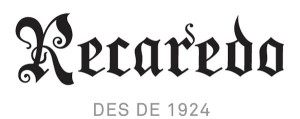 Recaredo is a small family-owned cava producer with big ambitions and wines that are somewhat different that the usual. They are organic and even biodynamic and make wine without any dosage. Ton Mata Moliner was recently leading a tasting of his wines that Magnus Hoffstein attended for BKWine. Read his full report on the Recaredo tasting and the discussion on BKWine Magazine: “It was a tasting that illustrated what cava can be, far removed from mass production and designer bottles.”
Recaredo is a small family-owned cava producer with big ambitions and wines that are somewhat different that the usual. They are organic and even biodynamic and make wine without any dosage. Ton Mata Moliner was recently leading a tasting of his wines that Magnus Hoffstein attended for BKWine. Read his full report on the Recaredo tasting and the discussion on BKWine Magazine: “It was a tasting that illustrated what cava can be, far removed from mass production and designer bottles.”
Travel, wine and food on the internet, how to fit it all together
 The “wine bloggers conference” is after all much easier to say than the Digital Wine Communications Conference… How can you communicate, tell stories, write articles on wine, travel and food and make them more engaging and readable? That was the theme for one of the panel debates at the #EWBC in Izmir in Turkey recently. Or in more detail: “Wine is much more than a tasting note and a score. To help us to become inspiring and authoritative sources of information, our panellists will share their views on how best to communicate about wine in the context of travel and food.”
The “wine bloggers conference” is after all much easier to say than the Digital Wine Communications Conference… How can you communicate, tell stories, write articles on wine, travel and food and make them more engaging and readable? That was the theme for one of the panel debates at the #EWBC in Izmir in Turkey recently. Or in more detail: “Wine is much more than a tasting note and a score. To help us to become inspiring and authoritative sources of information, our panellists will share their views on how best to communicate about wine in the context of travel and food.”
The panel included our own Per, from BKWine, Su Birch, CEO for Wines of South Africa (WOSA), Wendy Crispell, educator and blogger on food and wine, and Paola Tich, communications consultant and ex-journalist. Wink Lorch did her best to keep us all focussed. If you want to know more you can watch the whole session on communicating about wine, food and travel on our travel blog.. (EWBC is the short form of The Digital Wine Communications Conference, previously called the European Wine Bloggers Conference.)
What do the French drink at home?
 FranceAgriMer, a body linked to the French Ministry of Agriculture, has recently published statistics on how much still wine the French households buy and drink at home (sparkling wine not included). The French buy a little less wine every year. Last year each household bought in average 41, 44 litres of wine which is a decrease of 0,5 %. On the other hand, they spend more money on each bottle. The average price has gone up and is now 3, 17 euro per liter.
FranceAgriMer, a body linked to the French Ministry of Agriculture, has recently published statistics on how much still wine the French households buy and drink at home (sparkling wine not included). The French buy a little less wine every year. Last year each household bought in average 41, 44 litres of wine which is a decrease of 0,5 %. On the other hand, they spend more money on each bottle. The average price has gone up and is now 3, 17 euro per liter.
The French buy mostly red wine (58%). Rosé is 25% of the purchases and the whites account for 17%. Half of all the wine they buy is AOC (appellation wines), 28% are IGP (“Indication Géographique Protégée”, the old “vin de pays’ category), 11% is Vin de France (wine without a specified origin, called” vin de table “earlier), 8% are foreign wines and 3% are EU wines without specified origin. For the appellation wines Bordeaux accounts for 26%, Rhône Valley for 19%, Loire Valley for 12% and the South West for11%.
The big surprise for me is the figure for rosé wines. 25%! It must be the 35-hour week that forces people to spend too much time on a sunny terrace…
Read the whole report here.
Saint Emilion and Stradivarius for lunch
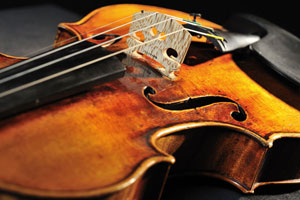 In late October we were invited by Bernard Magrez to a luxurious lunch at Le Cinq, star restaurant at the Hôtel Georges V in Paris. We were there to celebrate several things. Bernard Magrez’ Château Fombrauge in Saint Emilion had just been given its new classification, Grand Cru Classé, and he had only a few weeks earlier bought a new chateau in Bordeaux (it is getting difficult to keep track of them all).
In late October we were invited by Bernard Magrez to a luxurious lunch at Le Cinq, star restaurant at the Hôtel Georges V in Paris. We were there to celebrate several things. Bernard Magrez’ Château Fombrauge in Saint Emilion had just been given its new classification, Grand Cru Classé, and he had only a few weeks earlier bought a new chateau in Bordeaux (it is getting difficult to keep track of them all).
The chateau in question is Clos Haut Peyraguey in Sauternes, classified as Premier Grand Cru Classé 1855. And that brings us to the third thing worth celebrating. Bernard Magrez is now the only chateau owner in Bordeaux having four Grand Cru Classé chateaux in four different Bordeaux appellations. Something he seemed to be very proud of.The châteaux are
- Château Pape-Clement, Grand Cru Classé de Graves
- Château la Tour Carnet, Grand Cru Classé de Médoc 1855
- Château Fombrauge, Grand Cru Classé de Saint Emilion
- Clos Haut Peyraguey, Premier Grand Cru Classé de Sauternes 1855
All this was celebrated with a magnificent lunch prepared by chef Eric Beaumard. We were also treated to some pieces of music performed by violinist Mattthieu Arama, concertmaster of the Opera of Bordeaux, on Château Fombrauges own Stradivarius (bought by Magrez a year ago). My first encounter with a Stradivarius and very enjoyable it was.
More info: www.stradivarius-fombrauge.com/ and https://www.bernard-magrez.com.
White dry Bordeaux from André Lurton
 We love dry white Bordeaux wines and hope that more people will discover how delicious they are. This summer we had the opportunity to visit some of the Lurton chateaux (there are several) in Entre-deux-Mers and Pessac-Léognan in Bordeaux and taste the wines. André Lurton is a big producer of white dry white wines in Bordeaux and even a bit of an expert on the sauvignon blanc grape variety.
We love dry white Bordeaux wines and hope that more people will discover how delicious they are. This summer we had the opportunity to visit some of the Lurton chateaux (there are several) in Entre-deux-Mers and Pessac-Léognan in Bordeaux and taste the wines. André Lurton is a big producer of white dry white wines in Bordeaux and even a bit of an expert on the sauvignon blanc grape variety.
He lives at Chateau Bonnet in the Entre-deux-Mers, a property with over 200 hectares of vineyards. There he makes a very reasonably prices aromatic white, a classic blend of 50% sauvignon, 40% semillon and 10% muscadelle. (~8€)
One notch up in complexity you have Chateau Coucheroy from Pessac Léognan (~11€). The wine is fermented in oak barrels (not new) with a good body from the time on the lees without losing the freshness of the sauvignon. It’s 100% SB.
Another interesting wine in the Lurton range is Chateau de Rochemorin Blanc (~13€) also from Pessac Léognan. 100% SB. Flowery and fresh on the nose with a whiff of oak barrel. Good length and body on the palate without being heavy.
There is also the flagship, the Chateau la Louvière (Pessac-Léognan, 85% SB, 15% semillon) which is excellent. A recent vintage will set you back twenty something euro and we have recently even seen older vintage (from the chateau?) on sale in Sweden for around 30€. Aged white Bordeaux can be delicious!
Organic food and biodynamic wines in Tuscany
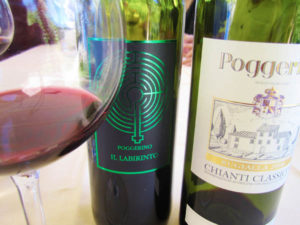 The Fattoria Poggerino is one of the few organic and biodynamic wineries in Chianti. It is run by Piero and Benedetta Lanza, brother and sister. Piero runs the wine cellar and Benedetta runs their agriturismo as well as being a very talented cook. This autumn we stopped by on our “Super Tuscan” wine tour for lunch and for a wine tasting, and of course a visit to the vineyard and the wine cellar. Read more about this delicious (literally) visit at Poggerino, with pictures and videos, on our travel blog.[divider_flat]
The Fattoria Poggerino is one of the few organic and biodynamic wineries in Chianti. It is run by Piero and Benedetta Lanza, brother and sister. Piero runs the wine cellar and Benedetta runs their agriturismo as well as being a very talented cook. This autumn we stopped by on our “Super Tuscan” wine tour for lunch and for a wine tasting, and of course a visit to the vineyard and the wine cellar. Read more about this delicious (literally) visit at Poggerino, with pictures and videos, on our travel blog.[divider_flat]
A new champagne discovery: Champagne Vautrain-Paulet
 The year is soon coming to its end and it will soon be time to plan what drink to finish it and celebrate the new year with. Or to have for dinner on New Year’s Eve. A champagne producer that we recently discovered is Champagne Vautrain-Paulet (it was recently introduced on the Swedish market).
The year is soon coming to its end and it will soon be time to plan what drink to finish it and celebrate the new year with. Or to have for dinner on New Year’s Eve. A champagne producer that we recently discovered is Champagne Vautrain-Paulet (it was recently introduced on the Swedish market).
Champagne Vautrain-Paulet can be found in the small village Dizy just a few kilometres from Epernay, across the river. It is a small family property with an annual production of no more than 30,000 bottles. We have tasted two of their fine champagnes.
Champagne Vautrin-Paulet Carte Blance Brut: Appely and a bit earthy on the nose, refreshingly dry. Good, soft mousse, light in style but with a good intensity on the palate, finishing on green apples and good fruit. Good value at its price (~17-28€). ~75% pinot noir & meunier, 20% chardonnay.
Champagne Vautrain-Paulet Blanc de Blanc: Classic, toasty and elegant, delicate and quite light. Excellent as aperitif and to a meal with dishes that do not have too strong flavours. ~15-25€.
More info www.champagne-vautrain-paulet.fr.
Wine events calendar
Send us an email if you have some event you want on the calendar.
Don’t be an egoist! Share with your friends and other wine enthusiasts! Forward the Brief to your friends! Suggest that they sign up for a free subscription !
© Copyright BKWine






